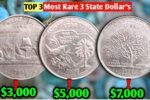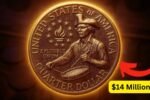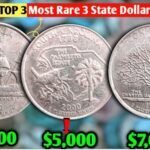Most people barely glance at the pennies they receive in change, often tossing them into jars, drawers, or even discarding them entirely. But in the fascinating world of numismatics, some of these unassuming coins could be worth a fortune. Among the most celebrated and valuable of them all is the Lincoln Wheat Penny. This iconic coin, first minted in 1909, has grown from common currency to a prized collectible, with certain rare editions fetching astronomical prices—even as high as $100 million.
A Presidential Tribute: The Origins of the Lincoln Wheat Penny
Introduced in 1909 to mark the 100th birthday of Abraham Lincoln, the Lincoln Wheat Penny was the first American coin to feature an actual historical figure rather than an allegorical design like Lady Liberty. Designed by Victor David Brenner, the coin bears a noble profile of President Lincoln on the obverse and a pair of wheat stalks flanking the words “One Cent” on the reverse—hence its nickname.
The Lincoln Wheat Penny remained in circulation until 1958, when the design was replaced by the Lincoln Memorial on the reverse side. Over its five-decade run, this penny saw numerous mint marks and variations, some of which have become the holy grail for coin collectors today.
The Legendary 1909-S VDB Lincoln Wheat Penny
One of the most famous and valuable versions of the Lincoln Wheat Penny is the 1909-S VDB. This particular edition is a standout for multiple reasons:
- Scarcity: Only 484,000 of these coins were minted in San Francisco.
- Initials Controversy: The initials “VDB” (Victor David Brenner) appeared prominently on the reverse. Due to public backlash, the Mint quickly removed them, making the few that exist with the initials highly collectible.
- Historical Significance: As the first U.S. coin to feature a real person, the design was revolutionary for its time.
A 1909-S VDB in pristine condition has sold for more than $100,000, and the most flawless specimens have crossed $168,000 at auction. For collectors, this Lincoln Wheat Penny represents a perfect blend of history, scarcity, and legacy.
The Mythical 1943-D Bronze Lincoln Wheat Penny
In 1943, due to the demands of World War II, the U.S. Mint switched from bronze to zinc-coated steel for penny production to conserve copper for military use. However, a few bronze planchets were mistakenly struck that year, creating one of the most coveted error coins in American history.
- 1943-D Bronze Variant: Only one authentic 1943-D bronze Lincoln Wheat Penny is known to exist.
- Unmatched Rarity: It is the only known specimen struck at the Denver Mint.
- Record Value: This unique coin sold for an eye-popping $1.7 million at auction.
This coin is the crown jewel of any collection, its existence legendary among collectors. Its value lies not only in its rarity but also in the sheer improbability of its creation.
Also Read – $1,000 Credit One Bank Settlement: What It Means, Who Qualifies, and How You Can Claim Your Payment
How to Identify Valuable Lincoln Wheat Pennies
Not all Lincoln Wheat Pennies are worth millions, but several may be worth significantly more than face value. Here are key characteristics that add value:
1. Mint Marks
Located below the date on the obverse, mint marks indicate where the coin was struck:
- “S” for San Francisco
- “D” for Denver
- No mark for Philadelphia
Certain combinations, such as the 1909-S VDB, dramatically raise a coin’s worth.
2. Condition and Grade
The better the coin’s condition, the higher its value. Grades range from Good (G-4) to Mint State (MS-70). Mint State coins show no signs of wear and command premium prices.
3. Minting Errors
Collectors treasure coins with minting errors:
- Double die errors
- Off-center strikes
- Clipped planchets
- Misaligned dies
A minting error like the 1943-D Bronze is what turns an ordinary Lincoln Wheat Penny into a million-dollar asset.
4. Metal Composition
From 1909 to 1942, most Lincoln Wheat Pennies were made of 95% copper. In 1943, the U.S. Mint temporarily used zinc-coated steel. Any deviation from the expected composition—such as a 1943 copper coin—is a huge red flag (and opportunity!) for collectors.
Proper Storage and Authentication
If you believe you own a rare or valuable Lincoln Wheat Penny, proper care and professional appraisal are critical.
Storage Tips:
- Use acid-free coin flips or archival holders
- Avoid direct handling to prevent oil damage
- Store in a cool, dry place away from sunlight
Authentication Services:
Two of the most trusted coin-grading services are:
- PCGS (Professional Coin Grading Service)
- NGC (Numismatic Guaranty Corporation)
These experts will verify authenticity, assess condition, and encapsulate the coin in tamper-proof packaging.
The Market for Lincoln Wheat Pennies
The market for the Lincoln Wheat Penny remains strong, with collectors, investors, and hobbyists driving consistent demand. Auction prices vary significantly based on grade and rarity, with major events like Heritage Auctions or Stack’s Bowers often featuring rare Lincoln Wheat Pennies that fetch tens or hundreds of thousands of dollars.
In 2023, a collector paid over $250,000 for a near-perfect 1909-S VDB. Meanwhile, common-date Wheat Pennies in good condition can still fetch $1 to $5 each, with higher prices for uncirculated examples.
True Stories of Penny Discoveries
There are countless real-world examples of people discovering rare Lincoln Wheat Pennies in change jars, garage sales, or inherited collections. One collector found a 1943 copper penny in a box of old coins passed down from a relative and later sold it for nearly $100,000. Another came across a 1909-S VDB in a $5 roll of pennies from the bank.
These stories serve as a reminder: always inspect your change. You might be sitting on a small fortune.
The Symbolism Behind the Coin
The Lincoln Wheat Penny isn’t just a collectible—it’s a symbol of American resilience, innovation, and respect for its leaders. It represents a shift in how we commemorate historical figures and highlights how even the most ordinary objects can carry extraordinary meaning.
Its depiction of Lincoln, a president revered for his role in preserving the Union and abolishing slavery, is more than ornamental. It reflects the ideals of justice, strength, and humility. Paired with the wheat stalks symbolizing American agriculture and prosperity, this coin is as meaningful as it is valuable.
Frequently Asked Questions
Q1: How can I tell if I have a valuable Lincoln Wheat Penny?
A1: Check the date, mint mark, and condition. Rare coins like the 1909-S VDB or 1943 Bronze variants are highly valuable.
Q2: Are all Lincoln Wheat Pennies valuable?
A2: Not all, but many are worth more than face value, especially rare dates, mint errors, and coins in uncirculated condition.
Q3: What is the best way to sell a Lincoln Wheat Penny?
A3: Use reputable coin dealers, auction houses, or platforms like eBay, but get the coin graded first to determine its market value.
Q4: Can Lincoln Wheat Pennies still be found in circulation?
A4: Yes, though rare, people still occasionally find them in circulation, particularly in coin rolls or old jars.
Q5: How much could a Lincoln Wheat Penny be worth?
A5: Values range from a few cents to over $1 million, depending on rarity, condition, and demand.
Final Thoughts
The Lincoln Wheat Penny is more than just a one-cent coin; it’s a tiny time capsule of American history and a potential treasure hiding in plain sight. Whether you’re an experienced collector or simply curious about the change in your pocket, it’s worth taking a closer look. From the iconic 1909-S VDB to the elusive 1943-D Bronze, the Lincoln Wheat Penny continues to astonish collectors and spark imaginations.
Next time you come across a penny, don’t dismiss it. You could be holding a piece of history—or even your ticket to unexpected wealth.
Some Important Link
| Download News APP | Click Here |
| WhatsApp Group | Click Here |
| Home Page | Click Here |
















